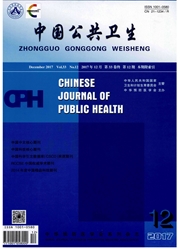

 中文摘要:
中文摘要:
目的查明东南沿海地区恙虫病的流行特征,为采取预防措施提供依据。方法在福建、浙江、江苏省选择有代表性的调查点,收集地理景观及流行病学资料 进行现场调查及实验研究,了解鼠类、恙螨与恙虫病的关系。结果东南沿海地区恙虫病按季节分布主要有2型。夏季型:流行于福建、浙江省 主要宿主动物为黄毛鼠、黄胸鼠 主要媒介为地里纤恙螨 流行于5-10月 恙虫病东方体为G illiam型。秋冬型:流行于江苏省 主要宿主动物为黑线姬鼠、褐家鼠 主要媒介为小盾纤恙螨 流行于10-12月 恙虫病东方体为Kawasak i型。结论福建、浙江、江苏省恙虫病的病原体型别、储存宿主、媒介恙螨与流行特征均有所不同,因此,采取的预防措施亦应有所区别。
 英文摘要:
英文摘要:
Objective To identify the epidemiological features of tsutsugamushi disease in south eastern costal areas of China to provide basis for the prevention of the disease. Methods Representative sites for the investgation in Fujian, Zhejiang and Jiangsu provinces were selected. Data on geographical landscape and the epidemic of the disease were collected. Field survey and experimental studies on rats and chigger mites in relation to tsutsugamushi disease were carried out. Results The seasonal distribution of tsutsugamushi disease in southeastern costal areas of China could be divided mainly into two types. The summer type was prevalent from May to October in Fujian and Zhejiang provinces. Main animal hosts were Rattus losea, R. flavipectus; main vector mite was Leptotrombidium deliense. The type of Orientia tsutsugamushi(Ot) was Gilliam. The autumn-winter type was prevalent from October to December in Jiangsu province and the main animal hosts were Apodemus agrarius, R. norregicus; main vector mite was L. scutellare. The type of Ot was Kawasaki. Conclusion The types of Ot, animal host, vector chigger mites and epidemiological features of tsutsugamushi disease are different in Fujian, Zhejiang and Jiangsu provinces. Thus, the preventive measures should be different.
 同期刊论文项目
同期刊论文项目
 同项目期刊论文
同项目期刊论文
 期刊信息
期刊信息
